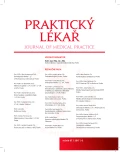Study of new anticoagulants – partial results
Authors:
A. Zatloukalová 1,2; J. Janoutová 1,2; M. Homza 3; M. Fedičová 1; V. Janout 1,2
Authors‘ workplace:
Ostravská Univerzita, Lékařská fakulta, Centrum epidemiologického výzkumu
Ředitel: prof. MUDr. Vladimír Janout, CSc.
1; Ostravská Univerzita, Lékařská fakulta, Ústav epidemiologie a ochrany veřejného zdraví
Vedoucí: prof. MUDr. Vladimír Janout, CSc.
2; Fakultní nemocnice Ostrava, Kardiovaskulární oddělení
Primář: MUDr. Miroslav Homza, MBA
3
Published in:
Prakt. Lék. 2017; 97(6): 259-263
Category:
Of different specialties
Overview
Until recently, warfarin was the only anticoagulant used in medical care. Because of its numerous side effects, especially various types of bleeding, new oral anticoagulants have been developed with the same or better safety. To date, several preparations have been developed, direct thrombin inhibitors (so-called gatrans) and direct inhibitors of haemocoagulation factor Xa (so-called xabans). To prevent CMP and other systemic of embolization events in patients with atrial fibrillation, the following substances (in the order in which they are listed) have been registered as a result of large clinical trials: dabigatran, rivaroxaban and apixaban. They have the same or better safety profile, but they need to be monitored for epidemiological reasons over the long term. There is also a need for more information on managing patients with bleeding because, with the exception of dabigatran, a specific antidote for other NOACs (NOvel Oral AntiCoagulantS) is not approved. The study included patients from cardiology ambulance taking new anticoagulants. Their basic characteristics were identified and, in particular, the adverse effects were observed. It was further investigated whether the occurrence of adverse events was related, for example, to the age of the patient or to the BMI group. The group contained 150 patients, which were divided into three groups according to the above mentioned anticoagulants. The primary objective of the study was to compare adverse events between all three of these anticoagulants. Statistical significance was set at 5%. The most bleeding effects had Xarelto, followed by Pradaxa. Eliquis was completely bleeding-free. Other side effects that included gastrointestinal problems, allergies, and more were most common with Eliquis. There was no statistically significant difference between the BMI groups, among the sexes and between age groups in the occurrence of adverse events for each anticoagulants and theme. This issue needs to be further addressed. More data is required for more valid results, so data collection will continue until the end of this year and the data will be analyzed again and evaluated. Practice recommendations will also be given after this step.
Keywords:
novel anticoagulants – dabigatran – rivaroxaban – apixaban
Sources
1. Brown JD, Shewale AR, Talbert JC. Adherence to Rivaroxaban, Dabigatran, and Apixaban for stroke prevention in incident, treatment-naïve nonvalvular atrial fibrillation. J Manag Care Spec Pharm 2016; 22(11): 1319–1329.
2. Cífková R, Vaverková H, Filipovský J, a kol. Summary of the European Guidelines on cardiovascular disease prevention in clinical practice (version 2012): Prepared by the Czech Society of Cardiology. Cor et Vasa 2014; 56(2): e169–e189.
3. Conolly SJ, Eikelboom J, Joyner C. Apixaban in patients with atrial fibrillation. N Engl J Med 2011; 364(9): 806–817.
4. Deitelzweig S, Farmer C, Luo X, et al. Risk of major bleeding in patients with non-valvular atrial fibrillation treated with oral anticoagulants: a systematic review of real-world observational studies. Curr Med Res Opin 2017; 33(9): 1583–1594.
5. Granger CHB, Alexander JH, McMurray JV, et al. for the ARISTOTLE Committees and Investigators. Apixaban versus warfarin in patients with atrial fibrillation. N Engl J Med 2011; 365: 981–992.
6. Kvasnička J, Penka M, Kvasnička T, a kol. Doporučení české společnosti pro trombózu a hemostázu České lékařské společnosti J. E. Purkyně pro bezpečnou léčbu novými perorálními antikoagulancii (NOAC) – dabigatran exilátem, apixabanem a rivaroxabanem. Vnitř. Lék. 2015; 61(6): 537–546.
7. Michalcová J, Penka M, Buliková A, Zavřelová J, a kol. Nová – přímá perorální antikoagulancia: aktuální přehled. Vnitř. Lék. 2016; 62(10): 805–813.
8. Patel MR, Mahaffey KW, Garg J. Rivaroxaban versus warfarin in nonvalvular atrial fibrillation. N Engl J Med 2011; 365(10): 883–891.
9. Pohlídalová A, Janoutová J, Homza M, Janout V. Nová antikoagulancia. Prakt. Lék. 2016; 96(3): 114–121.
10. Špinar J, Vítovec J, Špinarová L, Musil V. Profile of Czech AF 2012. Profile of atrial fibrillation patients receiving antithrombotic therapy. Cor et Vasa 2014, 56(3): e207–e216.
11. Wright C, Brown R, Cuker A. Laboratory measurement of the direct oral anticoagulants: Indications and impact on management in clinical practice. Int J Lab Hematol 2017; 39(Suppl 1): 31–36.
Labels
General practitioner for children and adolescents General practitioner for adultsArticle was published in
General Practitioner

2017 Issue 6
- Memantine in Dementia Therapy – Current Findings and Possible Future Applications
- Memantine Eases Daily Life for Patients and Caregivers
- What Effect Can Be Expected from Limosilactobacillus reuteri in Mucositis and Peri-Implantitis?
- Metamizole at a Glance and in Practice – Effective Non-Opioid Analgesic for All Ages
Most read in this issue
- Follow-up and long-term care in the Czech Republic – an overview of the current state and changes in bed capacity from the National Health Information System
- Inoperable form of alveolar echinococcosis of the liver
- Dilaceration of eye caused by a fire cracker explosion
- Study of new anticoagulants – partial results
